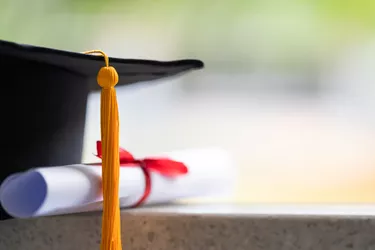
If you receive some form of financial aid – such as grants or loans – your decision to drop out of college will affect your financial aid award for future semesters in which you plan to enroll in school and potentially trigger repayment responsibilities. If you are attending college yet don't have a job or are underemployed, consider whether you can begin repayment of your financial aid if you drop of school tomorrow. While options like forbearance are sometimes available for putting off repayment, you can only put off repayment for so long.
Consider also: Definition of Outstanding Loans
Video of the Day
Video of the Day
Function of Financial Aid
The role of financial aid is to provide everyone, despite their ability to pay up front, with the opportunity to get a higher education. Scholarships and grants do not generally have to be repaid, unless you drop out, while loans must be repaid. Financial aid may be need-based or merit-based, and it can come from the federal government, state government, institution, foundations or other private sources.
Consider also: Types of Financial Aid for College
Dropping Out and Financial Aid
You might wonder, "What happens to student loans if you withdraw?" Dropping out of college usually means that repayment of your student loans is accelerated. Often, repayment must start six months after students drop out. However, this has temporarily not been the case through May 2022 due to a student loan repayment pause in response to the pandemic.
However, loans aren't your only worry. There's the 60 percent completion rule for financial aid that determines how much aid you can keep, and drop outs may have to repay part of their Pell Grants as a result. The percentage of Pell Grants that students must pay back is determined using a formula set by the Department of Education and will depend on when during a semester they drop out.
Additionally, institutional or private scholarships may have stipulations requiring repayment if you drop out of college during a semester in which you were using the aid to pay for classes.
Receiving Student Aid Refunds
By repaying financial aid, you're essentially providing a refund to the organizations that made an investment in your education by repaying the aid. However, you too may be entitled to a full or partial refund of the money paid to the institution for tuition and fees for the semester in which you dropped out. This will vary by institution, so check your institution's policy on refunds from withdrawals.
If you plan on dropping out, do so as early in a semester as possible, to ensure you get the biggest possible refund. If classes have yet to begin, you may be entitled to a full refund for the semester.
If you are owed a refund, you may not see any money. That's because the federal and state agencies that lent or gave you money must get repaid first. Typically, if your refund satisfies those debts for the semester in full, you then receive the rest. You can typically expect to receive a check from your institution within a few weeks of dropping out.
Consider also: How to Get a Student Loan Straight to Your Banking Account
Considerations for Dropping Out
Take careful stock to determine whether dropping out is an absolute necessity. If you decide to re-enroll later, your decision to drop out could hurt your ability to secure future financial aid.
You'll also want to think about, "What happens to your FAFSA if you drop out?" If you cannot afford to begin repaying your financial aid, dropping out can result in a default, which can affect your credit report and score negatively, preventing you from getting new credit in the future, such as private student loans.